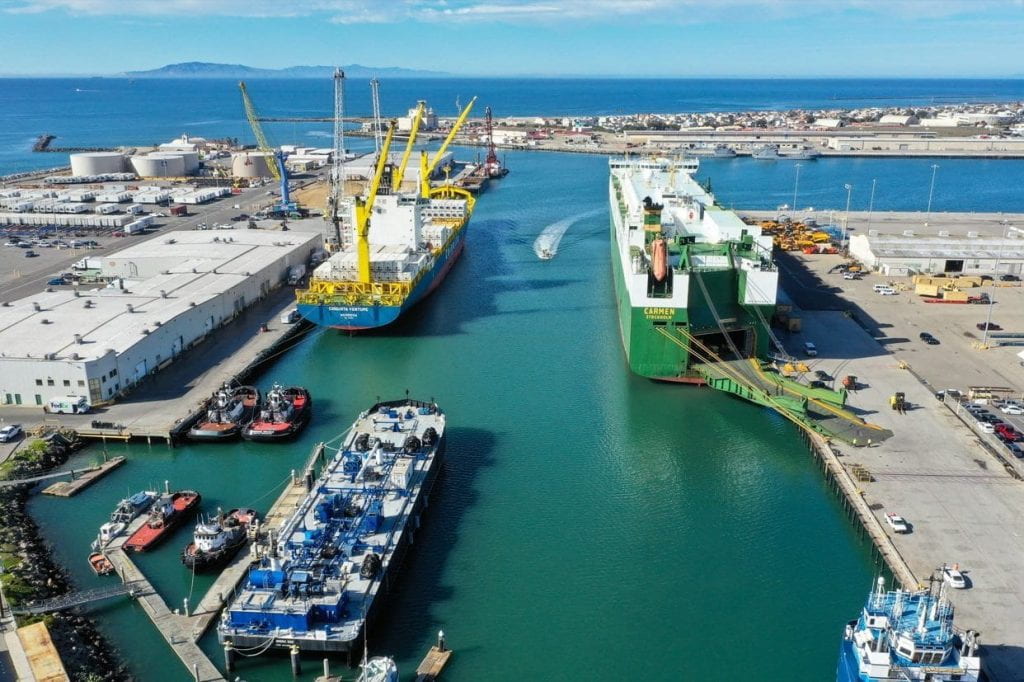By Jordan Yanowitz
Less than a decade ago, each morning, residents living near the Port of Hueneme would wake up with their cars covered in what appeared to be snow. On the coast of Southern California, however, it wasn’t snow falling on these communities, but the soot and particulate matter released from cargo ships docked at the nearby port.
Large ships are the backbone of our global economy but they remain a primary cause of smog pollutants across the globe. Since 2007, California has been leading the way in pushing shipping companies toward greening not just our coastal cities, but global shipping as a whole [1]. As of 2022, the majority of cargo ships, when docked at a California port receive onshore power, preventing over 80% of the pollution these ships would release into the air over coastal cities [2]. Over the next 5 years, additional classes of ships including tankers and auto carriers will be required to switch to onshore power, further reducing the smog released into port-adjacent cities and freeing these communities from the health burdens caused by these environmental pollutants.
These changes may be good for local residents, but shipping companies are less enthused. Equipping their ships to receive onshore power requires significant investment. As no other ports in the U.S. currently require onshore power, many corporations are simply opting to cross the Panama Canal, dropping their cargo at East Coast ports where these regulations have yet to be implemented. This has created a tough situation for many California ports, which depend on offloading cargo from ships to maintain their overhead.
The Port of Hueneme, located near Oxnard in Southern California, has not been spared from these economic moves. The Port of Hueneme specializes in offloading cars and bananas, and these regulations have placed new challenges for port managers. Already, container ships entering this port receive their power from onshore sources, which has been a tremendous boon for local residents – no longer do locals wake up with diesel “snow” covering their windshields. Starting in 2025, auto carriers, responsible for much of the Port’s revenue, will be required to move to onshore power. These ships require a massive amount of power, not only for moving across the ocean, but also to circulate air throughout the ship to prevent the risk of fire. The Port’s largest car-transport client, GLOVIS, with a fleet of over 100 auto carrier ships does not want to retrofit their ships. This has led managers at the Port of Hueneme to consider out-of-the-box solutions, including a crane to cover the smokestacks and take up the ship’s pollution. With half a million cars moving through this port each year and these regulations growing stricter by the year, it is up to the Port’s managers to ensure Hueneme remains a key player in the local and global economy.

Figure 1. A container ship next to an Auto-carrier at the Port of Hueneme, Photo courtesy of the Port of Hueneme.
The Port of Hueneme has been doing much more than just these renovations to create a truly sustainable port, as it also understands its key place in the community. Since its establishment in 1937, the Port has been providing critical jobs and revenue to fund local community projects [3]. For over a decade now, they have pioneered sustainability initiatives impacting the local communities. For example, since 2020, the Port has diverted food that would otherwise become waste to local community food banks. With a number of renewable energy projects in the works, both to continue to support on-shore power regulations and to increase clean power generation capacity, the Port of Hueneme is well on its way to becoming a hallmark example of the role that community-centered infrastructure plays in moving us toward a more sustainable world [4].
References:
- Phillips, Anna. “Ship Pollution Is Rising as the U.S. Waits for World Leaders to Act.” The Washington Post, WP Company, 6 June 2022, https://www.washingtonpost.com/climate-environment/2022/06/06/shipping-carbon-emissions-biden-climate/.
- Lee Hong Liang. “California Expands Shore Power Requirements to More Vessel Types.” Seatrade Maritime News, 31 Aug. 2020, https://www.seatrade-maritime.com/ports-logistics/california-expands-shore-power-requirements-more-vessel-types.
- “Community Benefit Fund.” Port of Hueneme, Port of Hueneme, 13 Apr. 2021, https://www.portofhueneme.org/cbf/.
- “Environment:.” Port of Hueneme, Port of Hueneme, 13 Apr. 2021, https://www.portofhueneme.org/community/environment.
